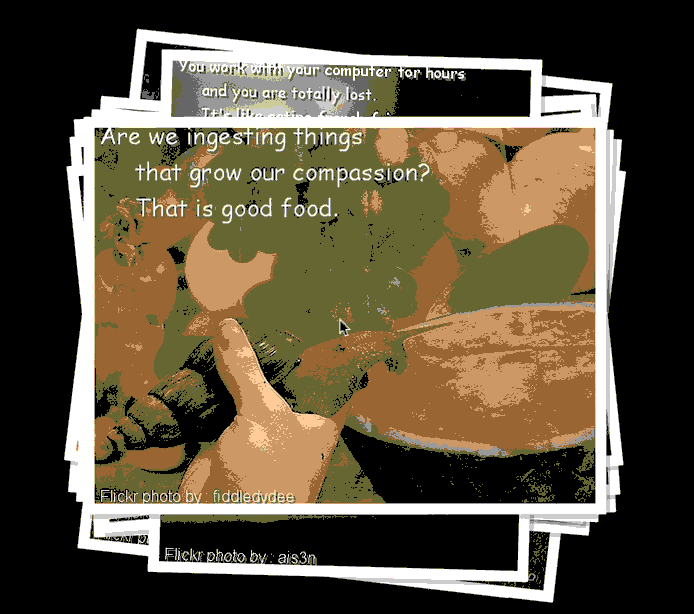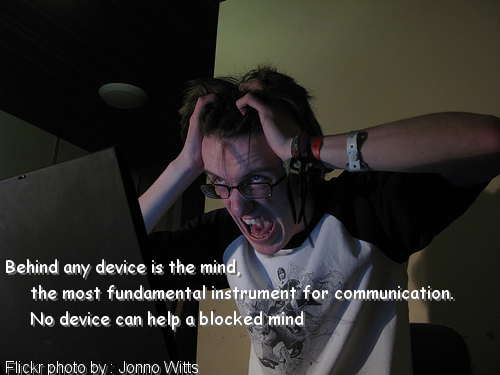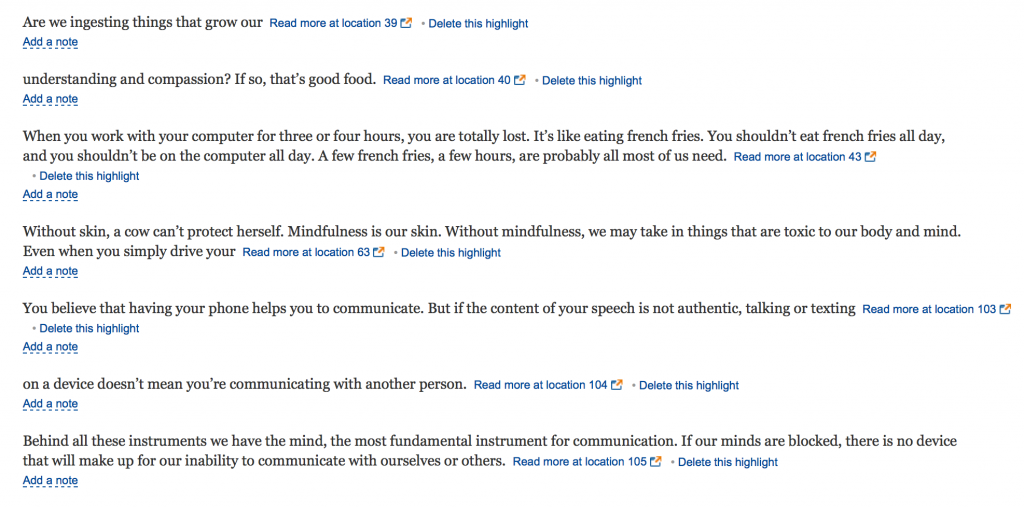“When you work with your computer for three or four hours, you are totally lost. It’s like eating french fries. You shouldn’t eat french fries all day, and you shouldn’t be on the computer all day. A few french fries, a few hours, are probably all most of us need.”
Thich Nhat Hanh also tells us that ‘mindfulness is our skin’ and that without we can absorb toxic substances.
I thought I would get our course blog started doing a ‘Nugget post’ before you have to start them next week. I want to use this to introduce you to the idea of nugget posts, the process of writing a blog post and also to explore some nuggets from The art of communicating.
For each required resource as we go through the weeks of this course, we’ll ask you to take a passage or quote that grabs you in some way and make that passage as meaningful as possible in a blog post. It could be a passage that puzzles you, or intrigues you, or resonates strongly with you. It could be a passage you agree with, or one you disagree with. The idea here is that the passage evokes some kind of response in you, one that makes you want to work with the passage to make it just as meaningful as possible. A good length for your nugget is about a paragraph or so. Too much, and it becomes unwieldy. Too little, and you don’t have enough to work with.
How do you make something as meaningful as possible? Well, use your imagination. You’ll probably start by copying the nugget into your post. From there, consider hyperlinks, illustrations, video clips, animated gifs, screenshots, whatever. Make the experience as rich and interesting as you can. And as we go along, you’ll have more and more of the work of our community to link to. In fact, linking and commenting are such vital and necessary parts of this course that I strongly suggest you spend time with IT tutorials learning how to do this well if you do not know yet.
Obviously, one of the main goals of this type of assignment is to get you to explore the resources carefully and respond to them imaginatively. Your work with “nuggets” should be both fun and in earnest. It should demonstrate your own deep engagement and stimulate deep engagement for your reader as well.
My preference would be for all of us to be blogging in the open work so that you could connect with the larger community of open education, but we are limited by the rules of the university. We can still apply the principles in the walled garden that is our private course blog. The 3 key things the blogging guide suggests you cover in all post were:
- The work you did
- What happened behind the scenes
- and narrate your process
The What
I read the book as part of my practice during the weekend just gone. My intention here was to quieten the mind and give the book the attention I felt it deserved. I have always loved Thich Nhat Hanh’s writing and I have never been able to pronounce his name. So, in my mind his name is TNH! I read the book in Kindle and used the highlight feature to keep key quotes.
I have not shared them but I could do, if others want to work with kindle highlights. My immediate response after finishing the book was that even 1 highlight would be a nugget to work with for a lifetime.
I ended up making some digital art to express how I felt – I created 10 posters with the quotes. I will not post them here as it is too resource intensive. I did also make an animation to express how overwhelmed I felt about the wisdom of the book.

To get to this animation: I took the quotes and summarised them in a short/long/short poem form called a Lune (I cheated I little as the form is actually 3-5-3) I then used a free poster maker to create my posters. I then wanted a gallery to show them and found something online, but it is a paid service and I am an open educator so I only recommend free services. I do like what it creates and it is very easy to use. If you visit this 30 days from when it was written, the link will have rotted unless I decide to pay.
This is the ‘what’ I did to make my reading meaningful.
The director’s cut: behind the scenes
As I was writing and re-writing the quotes I memorised some. It reminded me of a stay at a Benedictine Monastery and practicing lectio divina. There is a tangible quality, a deepening as we engage with words that resonate. I am a visual thinker so choosing images to make sense of the words is a further deepening and making connections with my existing knowledge and experience. Interestingly, I notice that my process has been quite introverted whilst some of the comments in our discussion board have been more focussed on making sense of the nuggets in the book in conversational settings. I am recommending the book and it will be a house warming present for a friend soon. It has made an impact beyond it being just a class reading.
Narrating my process
Faced with so much nourishment I found it hard to make a choice. A familiar Sankhara. Welcome. I call this mental formation ‘the just one more’. I find it as the mind quietens when i read, when I work, when plan. In good days I can just walk beside it and not act on it. I keep coming back to practicing discernment. What is needed right now? No more, no less. As a practice I picked one nugget.

The actual quote was:
“Behind all these instruments we have the mind, the most fundamental instrument for communication. If our minds are blocked, there is no device that will make up for our inability to communicate with ourselves or others.”
My work as an open educator focusses on this theme. I find so much written about how Google makes us stupid or smarter and very little about how what needs training is the tool that is behind the technology. Interpersonal attentiveness, seeing another (really seeing another) to listen deeply, is a scarce resource in my day to day interaction. I see people blaming time, technology, other people for their quality of life. I see only one thing: the most fundamental instrument of communication with ourselves and with others is our mind. It takes humility and courage to be willing to look in the mirror and commit to a practice of dialogue. This is a theme in life to work with in the way that Bruner suggests: through spiralling and iterative knowledge creation. Clearly there is reciprocal causation going on as we engage in mediated dialogue through our devices. Not all devices or software were created equal. I write this blog post in the open web and then I will re-publish in Blackboard. The conceptualising of ideas and associations does not come easily in an editor that harks back to 1970’s software. But may be that is just my rigid views about Learning management systems. There is a magical quality to being able to create together a community that has mindful communication as an affinity and we will never be co-located and some of us may never meet. That is a way that a device can help a blocked mind, it can help us find sangha to practice mind unblocking with practice.
